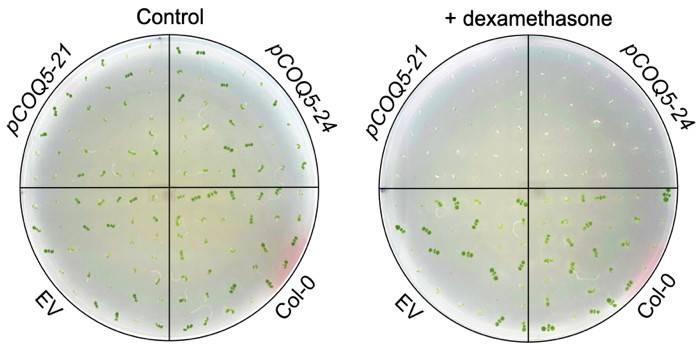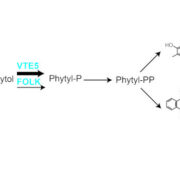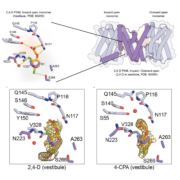Quinone Biosynthesis in Plastids and Cyanobacteria
Stutts et al. explore an evolutionary mystery in quinone biosynthesis.
https://doi.org/10.1093/plcell/koad202
By Lauren Stutts1, Scott Latimer1, Zhaniya Batyrshina1, Gabriella Dickinson1, Hans Alborn2, Anna K. Block2, and Gilles J. Basset1
1Department of Horticultural Sciences, University of Florida, Gainesville, FL 32611
2Center for Medical, Agricultural and Veterinary Entomology, ARS, USDA, Gainesville, FL 32608
Background: Prenylated quinones are membrane-associated metabolites that carry electrons in respiration and photosynthesis. Some of them double as antioxidants and vitamins. Most quinones fall within two chemical families: the benzoquinones (e.g. ubiquinone, plastoquinone-9) and the naphthoquinones (e.g. phylloquinone, menaquinone). Furthermore, some prenylated quinones (such as ubiquinone and phylloquinone) carry a methyl group on their quinone ring at the position adjacent to the prenyl side chain, while others (such as plastoquinone-9 and demethyl-menaquinone) lack this substitution. The presence or absence of this methyl group is functionally critical and is determined by the activity of an enzyme called quinone C-methyltransferase. Some prokaryotes use the same quinone C-methyltransferase to synthesize benzoquinones and naphthoquinones.
Question: Do plants, like certain bacteria, exploit the catalytic promiscuity of quinone C-methyltransferases to synthesize both ubiquinone and phylloquinone?

Findings: Phylogenetic reconstructions showed that quinone C-methyltransferases segregate into two clades. Clade 1 members are distributed throughout eukaryotic and prokaryotic lineages, excluding cyanobacteria, and include mitochondrial C-methyltransferases required for ubiquinone biosynthesis. Clade 2 members, in contrast, are specific to cyanobacteria and plastids, where they are required for the biosynthesis of phylloquinone. Functional complementation assays in Escherichia coli indicated that clade 1 enzymes can methylate both benzoquinones and naphthoquinones, but clade 2 members only methylate naphthoquinones. Expressing a bi-functional clade 1 enzyme in the cyanobacterium Synechocystis or in Arabidopsis (Arabidopsis thaliana) plastids produced a new-to-nature methylated variant of plastoquinone-9. Methyl-plastoquinone-9 behaved as an antimetabolite of plastoquinone-9 and inhibited photosynthesis. These data demonstrate that in cyanobacteria and plastids, the presence of plastoquinone-9 acts as a selective force for the emergence of strictly mono-functional demethyl-naphthoquinol methyltransferases.
Next steps: The discovery that methyl-plastoquinone-9 is a potent antimetabolite of plastoquinone-9 offers prospects for discovering novel herbicides and algicides.
Lauren Stutts, Scott Latimer, Zhaniya Batyrshina, Gabriella Dickinson, Hans Alborn, Anna K. Block, and Gilles J. Basset. (2023). The evolution of strictly monofunctional naphthoquinol C-methyltransferases is vital in cyanobacteria and plastids. https://doi.org/10.1093/plcell/koad202





